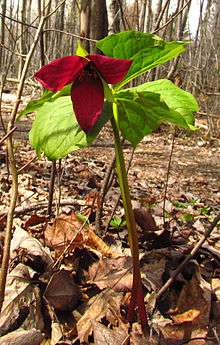Trillium erectum
| Trillium erectum | |
|---|---|
 | |
| Scientific classification | |
| Kingdom: | Plantae |
| Clade: | Angiosperms |
| Clade: | Monocots |
| Order: | Liliales |
| Family: | Melanthiaceae |
| Genus: | Trillium |
| Species: | T. erectum |
| Binomial name | |
| Trillium erectum | |
| Synonyms[2] | |
|
Synonymy
| |
Trillium erectum, also known as red trillium,[3] wake-robin, purple trillium,[4] Beth root, or stinking Benjamin,[5] is a species of flowering plant.
The plant takes its common name "wake-robin" by analogy with the European robin, which has a red breast heralding spring.
Distribution
It is native to the Eastern United States[2] and eastern Canada at least as far north as Lac-Pénobscot, Quebec.[6]
It is a spring ephemeral, an herbaceous perennial whose life-cycle is synchronised with that of the deciduous forests where it lives.

Description
Trillium erectum grows to about 40 cm (16 in) in height with a spread of 30 cm (12 in), and can tolerate extreme cold in winter, surviving temperatures down to −35 °C (−31 °F).
The leaves contain calcium oxalate crystals and crystal raphide, and should not be consumed by humans.
Like all trilliums, its parts are in groups of three, with 3-petalled flowers above whorls of pointed triple leaves.[7] The flowers are a deep red colour, though there is a white form. The flowers have the smell of rotting meat, as they are pollinated by flies.
Species Complex
Trillium erectum shares many anatomical details with other North American Trillium species.[8][9][10] These species hybridize in the wild, which has led some researchers to group them into a species complex, specifically, a syngameon of semispecies.[11][12] The combinations of traits that are supposed to differentiate members of the complex from one another are sometimes inconsistently combined in wild populations. This has led some researchers to declare the individual species invalid, and refer to the species complex collectively as T. erectum (sensu lato).[13] Others acknowledge the existence of introgression and hybrid swarm formation between some or all complex members, but maintain that the named species within the complex represent convenient groups with common features.[14][15]
Members of the Erectum complex have flowers with the following commonalities: (1) petals that are coarse and stiff in texture (in contrast with the wavy edges of other species), (2) petals that do not change color after pollination, (3) petals with prominent, netted veins, (4) fleshy stigmas that are attached to the ovary separately, without a common style, and (5) conspicuous, deeply-ridged ovaries.
North American members
- T. cernuum
- T. erectum
- T. flexipes
- T. rugelii
- T. simile
- T. sulcatum
- T. vaseyi
The Asian species T. camschatcense, resembles the North American T. flexipes very closely, and itself has close relatives with similar floral features. However, trillium speciation in this group of Asian species is characterized by differences in chromosome number, with hybrids more definitively distinguishable from parent species by karyotype.
- T. apetalon
- T. camschatcense
- T. channellii
- T. hagae
- T. smallii
- T. tschonoskii
Varieties
Named varieties include:[2]
- Trillium erectum var. album (Michx.) Pursh
- Trillium erectum var. erectum
Cultivation
Trillium erectum is cultivated as a flowering ornamental plant. It has received the Award of Garden Merit from the Royal Horticultural Society.[16]
References
- ↑ "Trillium erectum". NatureServe Explorer. NatureServe. Retrieved 2008-05-02.
- 1 2 3 Kew World Checklist of Selected Plant Families
- ↑ "Trillium erectum". Natural Resources Conservation Service PLANTS Database. USDA. Retrieved 15 December 2015.
- ↑ Dickinson, T.; Metsger, D.; Bull, J.; & Dickinson, R. (2004) ROM Field Guide to Wildflowers of Ontario. Toronto:Royal Ontario Museum, p. 79.
- ↑ Stinking Benjamin: A trillium that by any other name would smell so sweet Archived 2011-12-10 at the Wayback Machine., adirondack almanack
- ↑ https://mffp.gouv.qc.ca/publications/forets/connaissances/ecosystemes-lac-penobscot.pdf
- ↑ RHS A-Z encyclopedia of garden plants. United Kingdom: Dorling Kindersley. 2008. p. 1136. ISBN 1405332964.
- ↑ Barksdale, Lane (1938). "The pedicellate species of Trillium found in the southern Appalachians". Journal of the Elisha Mitchell Scientific Society. 54 (2): 271–296. JSTOR 24332541.
- ↑ Case, Frederick W.; Case, Roberta B. (1997). Trilliums. Portland, Oregon: Timber Press. ISBN 0-88192-374-5.
- ↑ Patrick, Tom (2007). "Trilliums of Georgia". Tipularia. 22: 3–22.
- ↑ Millam, KC (2006). The Trillium erectum species-complex (Melanthiaceae): Insights from molecular systematics and biogeography (PhD). University of Wisconsin at Madison.
- ↑ Stoehrel, Christina Pampkin (2010). A study of the systematic relationships between members of the Trillium erectum complex (MSc). Western Carolina University.
- ↑ Friesner, Ray C. (1929). "The genus Trillium in Indiana". Butler University Botanical Studies. 1: 29–40.
- ↑ Patrick, Thomas S. (1984). "Trillium sulcatum (Liliaceae), a new species of the southern Appalachians". Brittonia. 36 (1): 26–36. JSTOR 2806287.
- ↑ Case, Frederick W. "Trillium". Flora of North America, eFloras.org. Missouri Botanical Garden, St. Louis, MO & Harvard University Herbaria, Cambridge, MA.
- ↑ "RHS Plant Selector - Trillium erectum". Retrieved 7 June 2013.
External links
| Wikimedia Commons has media related to Trillium erectum. |
